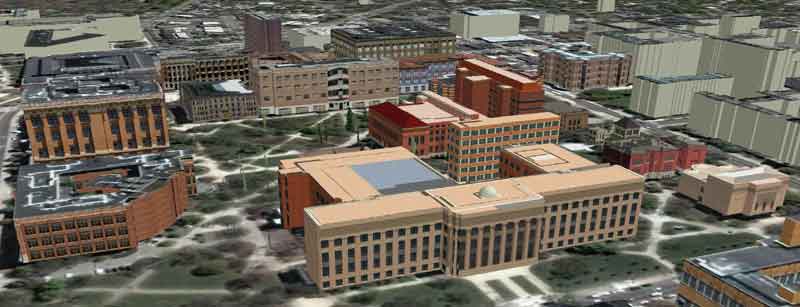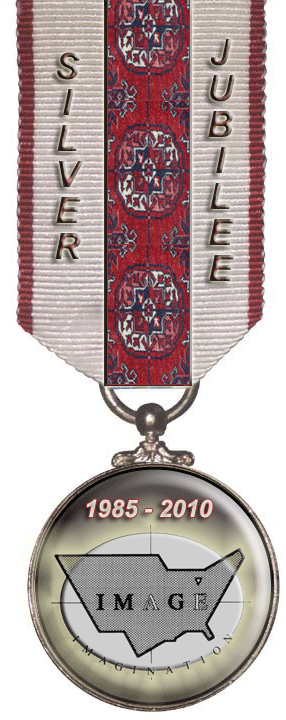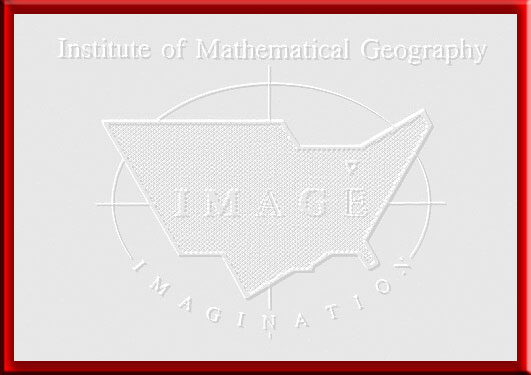| SOLSTICE: An Electronic Journal of Geography and Mathematics. (Major articles are refereed; full electronic archives available). Persistent URL: http://deepblue.lib.umich.edu/handle/2027.42/58219 |
 |
| SOLSTICE: An Electronic Journal of Geography and Mathematics. (Major articles are refereed; full electronic archives available). Persistent URL: http://deepblue.lib.umich.edu/handle/2027.42/58219 |
 |
 |
Fractals Take A
Non-Euclidean
Central Place Sandra L. Arlinghaus, Ph.D., The University of Michigan Introduction Central place geometry looks at groupings of hexagons as they tile the Euclidean plane. Pattern within these groupings may be interpreted as representing various elements of how cities share space. The geometry plays out over the unbounded surface of the Euclidean plane; the interpretation surface, however, involves the bounded surface of the Earth (roughly a sphere). One might ask if tilings of regular polygons could suggest other surfaces as a basis for similar interpretation. Euclid's Fifth ("Parallel") Postulate states that given a line, and a point not on that line, there is exactly one line through that point that does not intersect the given line. That is, the newly drawn line is "parallel" to the given line. In "Non-Euclidean" geometries the Parallel postulate does not hold (Coxeter, 1961, 1965). One of these non-Euclidean geometries, that admits multiple rather than unique parallels, is called "hyperbolic" geometry. For inspiration for that name, consider the hyperbola: multiple branches through a single point not on a given line might all be asymptotic to the given line--they do not intersect it. Of course, as the process becomes infinite, one might imagine the asymptote getting to the line--of the "parallels" meeting at a point at infinity. Most of us live in an Euclidean universe. We may function in other ways, but when we attempt to capture the geometry of our lives we do so, for the most part, in the Euclidean plane. To do otherwise, is jarring to most. |
||||||||||||||||||||||||||||||||||||||||||||||||||||||||||||||||||||||||||||||||||||||||||||||||
| Conventional
Central
Place Geometry: Fractal Characterization The patterns that emerge from grouping sets of hexagons according to K=3, K=4, and K=7 principles are familiar to even beginning geography students. What is perhaps not as familiar is the use of fractal geometry to produce these patterns from number theoretic properties (Arlinghaus, 1985; Arlinghaus and Arlinghaus, 1989). See the linked materials for a full explanation (Spatial Synthesis Ebooks); Figures 1.a, 1.b, and 1.c show (respectively) how to create a generator to form appropriate pattern for the K=7, K=4, and K=3 hierarchies. Iteration of the generator at different geographic scales produces the entire landscape as suggested in Figure 1.d which shows the next level of generator scaling and iteration (Arlinghaus and Arlinghaus, 2005).
An
advantage to the fractal
approach is that it permits
complete systematic extension of process to
higher K-values
and, at the
same time, allows complete solution to existing
open questions.
One broad concern, however, that is not
addressed in this approach or
in any other within the Euclidean plane is the
issue of bounding the
process (rather than allowing it to continue to
indefinite
extent). In the world of fine art, Maurits
Escher addressed this
issue elegantly with his Circle Limit Series in
which pattern that
replicates indefinitely is confined within the
boundary of a "limiting"
circle. |
|||||||||||||||||||||||||||||||||||||||||||||||||||||||||||||||||||||||||||||||||||||||||||||||||
|
The
Hyperbolic Plane: Poincaré Disk Model
The
difference between the polygon on the sphere and a
polygon in the
hyperbolic plane is that the sphere has constant
positive curvature
whereas the hyperbolic plane has constant negative
curvature, so one
must imagine sides that are convex (bulge out) on
the sphere would be
sides that are concave (sink inward) in the
hyperbolic plane (and
vice-versa).
With the
curvature issue, and the shrinking of polygons
with distance from the
center, in mind, a natural question is to ask
about the nature of
tilings of this new space.
|
|||||||||||||||||||||||||||||||||||||||||||||||||||||||||||||||||||||||||||||||||||||||||||||||||
| The
Hyperbolic
Plane: Tilings Data compression and the Fibonacci sequence The Fibonacci sequence is a number pattern that has seen, and continues to see, application in a number of different arenas. The sequence itself is generated as follows: Start with 1; add the preceding number to it (there is none) generating the next term which is also 1. Then add this new 1 to the previous term generating 2; then add 2 and 1, and so forth, to create the following number pattern: 1, 1, 2, 3, 5,
8, 13, 21, 34, 55, 89, 144,...
Some
characterizations
of this sequence simply have it begin as 1, 2, 3,
5,
8, 13, 21, 34, 55, 89, 144,... Whichever is
used, its
applications are deep and well known.
Indeed, an entire journal, The Fibonacci
Quarterly, is
devoted to its theory and
applications. Using it to represent
phyllotaxis and the
arrangement of spiral leaf patterns on branches or
the spiral
arrangement of cells on the skin of a pineapple
have been with us for a
long time. So too has an interpretation of
the sequence in terms
of the way that rabbits reproduce.
More recent applications employ the sequence in creating a universal computer code that will stem error propogation in computing systems. This property, and others, classify Fibonacci coding as a "Lossless" Entropy Encoding Data Compression Method. Pattern compression in the hyperbolic plane and the Fibonacci sequence Series and Wright note that tilings, as well, can create interesting methods of data compression through pattern compression. They note the following example involving similar tilings of both the Euclidean plane, Figure 3.a, and the Hyperbolic plane (realized in the Poincaré Disk Model), Figure 3.b.
Simple
enumeration
of bands of polygons surrounding a chosen central
polygon
reveals a numerical compression of pattern.
Of particular
interest, note that once again the Fibonacci
sequence gives a
systematic basis for the greater numerical
compression available in the
hyperbolic plane (Series
and
Wright). Figure 4.a shows the simple
linear number
pattern that emerges from the hexagonal tiling of
the Euclidean plane
while Figure 4.b captures systematically the
pattern in the hyperbolic
plane.
Pattern
compression
in the hyperbolic plane is more than 4500 fold
greater than
in the Euclidean plane at the level of n=12 and this
compression rate
appears to increase as n
increases (Figure 5).
It
remains
to
offer formal proof of this observation; however,
it seems clear
that the observation is true since the Fibonacci
sequence itself, let
alone the 2nth
Fibonacci
sequence, becomes large faster than does the
sequence of natural
numbers.
|
|||||||||||||||||||||||||||||||||||||||||||||||||||||||||||||||||||||||||||||||||||||||||||||||||
| Central Place
Hierarchies in the
Hyperbolic Plane Possible tilings While the observation by Series and Wright concerning the Fibonacci sequence in association with an heptagonal tiling of the hyperbolic plane appears both interesting and important, one might ask about other tilings of the plane and such association with the Fibonacci sequence, or other ideas, as a compression tool. An article in Wikipedia is useful in classifying possible tilings of the hyperbolic plane as realized in the Poincaré Disk Model. The reader is encourage to take a look at the link above and study the beautiful and highly symmetric patterns that emerge. Central Place Theory One of the "other ideas" that seems natural to consider as a compression tool is that of the fractal. Thus, a logical next step might be to try to merge the fractal compression from central place theory (and hexagonal tilings of the Euclidean plane) with a corresponding construction in the hyperbolic plane (Poincaré Disk Model) in order to assign fractal dimension to these patterns as ways to analyze the extent to which space is "filled" by them in the limiting process. Tiling by heptagons In the spirit of the example from Series and Wright, begin by considering the heptagonal tiling of the hyperbolic plane. Figure 6.a shows selection of a generator, similar to the generator for K=7 in the Euclidean case above (Figure 1.a) that will generate, when scaled appropriately and applied throughout the Disk, the entire network mesh. Here, the generator has four sides; in the corresponding Euclidean case the generator had 3 sides.
To continue the central place theory extension, one might ask about the cases for K=4 and K=3. A natural appoach, for K=4 for example, is to consider using as a generator one that surrounds half the area of a heptagon in the hyperbolic plane. Then, apply this generator in an "in and out" fashion to eventually generate a set of polygons that will cover 7*0.5 + 1 amount of heptagonal cells. The problem with this approach is that the "in and out" approach requires an even number of sides in the basic cell; otherwise, two "outs" are adjacent and the inner central cell becomes the wrong shape. Thus, the hierarchy cannot be produced. Figure 7 shows the beginning of this application of a natural generator, with reference to the underlying base so that the difficulty with iteration is clearer.
Prime numbers and polygon shape
Clearly
one cannot examine each individual case, as with
Figures 6 and 7, to determine when a particular
tiling might or might
not be
generated through fractal generation. One
easy approach to this
problem is to look at the number-theoretic
properties of the base cell
of the tiling. In the case of hexagons,
the unique factorization
of 6 is 3*2. Thus, one can look to
generating 1/3 (K=3) and 1/2
(K=4)
polygonal pieces in
association with fractal iteration. In
the case of a prime number, such as 7, one can
find only the natural
surrounding pattern of full tiles--no fractional
tiles.
With this idea in mind, move now to considering other tilings of the hyperbolic plane as candidates for calculation of fractal dimension. A natural place to begin is with tiling by hexagons. Tiling by hexagons One of the characteristics that a central place style of tiling has is that cells on each side of a central cell touch other cells with a side in common with that central cell. Thus, the tiling by hexagons shown in Figure 8 is not this sort of tiling: tiles 1 and 2 are in correct position in relation to the central cell and to each other. So also are the polygon pairs 3 and 4, as well as 5 and 6. However 2 and 3 are separated by an x cell, as are 4 and 5, as well as 6 and 1. The required adjacency pattern is only partially present and so this case is discarded (for now) as not a true related central place case. Thus, one sees why Series and Wright chose the heptagonal tiling, rather than an hexagonal tiling, of the hyperbolic plane as the one naturally associated with the hexagonal tiling of the Euclidean plane. One could, of course, choose other tilings (Woldenberg, 1968). The point here is to indicate what tiling of the hyperbolic plane is, or is not, similar to a tiling of the Euclidean plane by hexagons.
Tiling by pentagons
As in the case above, there are gaps separating tiles. This time, not in pairs but between every tile surrounding the central tile. Figure 9 illustrates this difficulty (which is more extreme than in Figure 8) using notation parallel to that employed in Figure 8. Again, as with the hexagonal tiling, this case which might have appeared attractive at the outset, is discarded as well: its level of violation of a basic premise is even more extreme than is the case with the hexagonal tiling.
Tiling
by octagons
The tiling of the hyperbolic plane shown in Figure 10 is not even as close to a central place net as those in either Figure 8 or Figure 9. Here, the central octagonal cell is surrounding by 8 cells with correct adjacency but they are hexagonal rather than octagonal cells. The next layer out has octagonal cells with no adjacency--each pair of octagonal cells is separated by an hexagonal cell.
It remains an
open
question to determine if there are any other
true
central place net styles of tiling of the
hyperbolic plane (there were
with the Euclidean plane however there only
the case of square tiles
(Arlinghaus, 1992) is of interest since a
hexagon may be decomposed
into triangles). Examination of cases
did suffice in the
Euclidean case and it may well be sufficient
in the hyperbolic case, as
well--a quick examination of the visual
pattern displayed in the
Wikipedia article suggests no others;
however, a more systematic
search, based on careful notational analysis
rather than solely on
visual pattern, is necessary to prove there
are no others.
Indeed, that is one direction for the
future--to prove uniqueness of a
single central place net for hyperbolic
space.
|
|||||||||||||||||||||||||||||||||||||||||||||||||||||||||||||||||||||||||||||||||||||||||||||||||
For the Future...
|
|||||||||||||||||||||||||||||||||||||||||||||||||||||||||||||||||||||||||||||||||||||||||||||||||
| Related
Materials General links (last accessed June 15, 2010) and references:
|
|||||||||||||||||||||||||||||||||||||||||||||||||||||||||||||||||||||||||||||||||||||||||||||||||
|
.

Solstice:
An Electronic Journal of Geography and
Mathematics, |
|
Congratulations to all Solstice contributors. |
| Remembering
those who
are gone now but who contributed in various ways to Solstice or
to IMaGe
projects, directly or indirectly, during the first 25
years of IMaGe: Allen K. Philbrick | Donald F. Lach | Frank Harary | H. S. M. Coxeter | Saunders Mac Lane | Chauncy D. Harris | Norton S. Ginsburg | Sylvia L. Thrupp | Arthur L. Loeb | George Kish | |